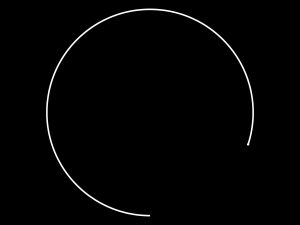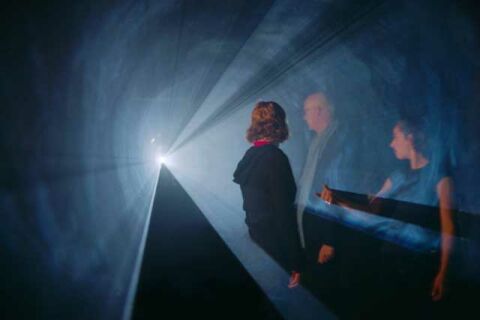
 |
| still from Anthony McCall. "Line Describing a Cone" (1973). Film frame from the 24th minute. |
Program:
Splitting (Gordon Matta-Clark, 1974), 16mm, color and black & white, silent, 11
minutes
Office Baroque (Gordon Matta-Clark, 1977), 16mm (projected on DVD), color,
sound, 44 minutes
Conical Intersect (Gordon Matta-Clark, 1975), 16mm, color, silent, 18 minutes
Line Describing a Cone (Anthony McCall, 1973), 16mm, black & white, silent, 30
minutes
Whenever Gordon Matta-Clark (1943-1978) cut into the walls, floors and ceilings
of buildings – the results of which he referred to as his "cuts" – he did many
things. He subverted notions of public and private space. He questioned the
function of architecture in society, the role of art in and out of the gallery,
the role of gender in art. But the simplest and most direct thing he did was to
let in the light. Matta-Clark's cuts "lit" buildings in subtle and sometimes
spectacular ways. Each of tonight's films – Splitting, with its giant
sundial of a house; Conical Intersect opening up a building to the
streets and skies of Paris; and Office Baroque's spectacular sunlight and
shadow – testifies to the importance of light in Matta-Clark's work. Along with
Anthony McCall's elegant, primal Line Describing a Cone, these films make
a fitting opening to Available Light, a five-part film series devoted to the use
of light in artists' films.
One of Matta-Clark's first large-scale cuts, titled Splitting, happened
in 1974. Matta-Clark asked his dealers – the New York gallery owners Holly and
Horace Solomon – if they knew of any buildings which he could cut in half. The
Solomons owned a small house on a plot of land in Englewood, New Jersey ("a New
York City bedroom suburb," as the film's charming intertitles describe it). The
house was set to be torn down for "urban renewal," and Matta-Clark was given use
of it.
He made two parallel cuts down the center of the house. Then, using jacks, he
beveled the foundation in a way that allowed him to tip the back of the house
back slightly. (A photograph of the completed work, with the sun shining through
the crack at the center of the house, became an iconic image of 1970s art.)
The film Splitting documents this methodical but rather fascinating
process, and at the same time provides an almost emblematic example of Matta-Clark's
filmmaking style. An opening shot establishes the environs, complete with a DO
NOT OCCUPY sign – a sure indicator that Gordon Matta-Clark is somewhere nearby.
We see the parallel cuts being made, and a brief sequence studying the light
effects created.
In the next sequence, a riotous masculinity comes to the fore: power tools,
hammers, shirtless men knocking out cement blocks and turning jacks, a parody of
slapstick comedy as Matta-Clark pretends to hold up the house, and a moment of
daredeviltry where we realize that someone is filming from beneath the
house that, at this point, is standing only on the set of jacks.
A sudden cut back to the inside of the house shows the completed work, a
wondrous amalgam of beauty and danger. As in all tonight's films, we see people
interacting with the work, like figures in a landscape. This small, glorious
film ends with a title card alerting us to the destruction of the work - a
common occurrence in Matta-Clark's films.
Office Baroque was one of Matta-Clark's last major works, completed in
October 1977. The documentary was filmed by Eric Covents and Roger Steylaerts.
It is professionally produced and contains many beautiful tracking and panning
shots, in addition to sequences in which Matta-Clark talks at length about the
work.
An empty five-story office building in Antwerp was used for the project. Matta-Clark
made two circular cuts which started inside the building, and went out through
the roof. The two cuts took the shape of intertwining circles, inspired by the
accidental rings left by teacups on paper. In an interview, Matta-Clark
described the work: "Where these circles crossed, a peculiar, almost row-boat
shaped hole resulted and was mutated from floor to floor as structural beams and
available floor space dictated."
A long sequence at the end of the film celebrates the play of light created by
Matta-Clark's cuts. In one particularly moving image, a sunbeam on the floor is
seen extending, in exact proportion, one of the circular cuts.
Matta-Clark was invited to create Conical Intersect for the 1975 Paris
Biennale. A somewhat controversial site was chosen – a nearly three hundred
year-old building about to be demolished in the modernization of the Les Halles
district of Paris. Conical Intersect coincided with the construction of
the Pompidou Centre (the French National Museum of Modern Art), which can be
seen adjacent to Conical Intersect throughout the film.
Conical Intersect was a complex, interlocking set of cones, starting at
about the third floor of the building, with a large hole facing the street. The
film begins with the opening of this hole, small chunks of plaster flying
mysteriously out of the wall. Other aspects of the work's construction are shown
– notably, much of the cutting was done by hand using simple tools. Matta-Clark
obliquely comments on the somewhat puzzled reception of the work by showing
people on the street studying the visible hole, some of them looking decidedly
bemused. As in Splitting and Office Baroque, camera pans
extensively document the finished work, and also show some of the fantastical
views of the Paris streets below. A final sequence intercuts shots of visitors
to Conical Intersect with the eventual destruction of both the work and
the building, by a large crane smashing the walls. (More on this final sequence
below.)
Destruction of his work was nothing new to Matta-Clark – it was, so to speak,
part of the territory, given that he worked almost exclusively in sites whose
disuse was considered merely a prelude to "urban renewal." Both Splitting
and Conical Intersect end with the destruction of the works documented,
and almost half the running time of Bingo (a film not seen tonight) is
devoted to that work's demolition by bulldozer. At the time of Matta-Clark's
death in 1978, Office Baroque was the only one of his building cuts
remaining in existence. Despite a three-year effort to save it, it too was
eventually demolished.
It is fortunate that Matta-Clark documented many of his works on film, which
gives the fullest sense possible of how it must have felt to see his works from
the inside. But this can be deceptive. Matta-Clark described the visual
complexity of Office Baroque as "almost undocumentable," and even in
these films there remains something elusive about these works, namely the
profound sense of disorientation that they apparently caused in viewers.
Perhaps this disorientation was caused by what Matta-Clark did to his floors. In
her book on Matta-Clark's work, Object To Be Destroyed, Pamela Lee points
out that by including floors as well as walls in his cuts, Matta-Clark
"effectively toyed with the scale of the work at the very place from which one
makes determinations of scale." And Matta-Clark himself commented approvingly on
the "surprise and disorientation" caused by Office Baroque.
In Matta-Clark's films, this dislocation works in time as well as space. About
halfway through Conical Intersect, after we've seen the work take shape,
bystanders start to appear in it – moving through the spaces at odd angles, or
simply standing inside the shapes of the piece, framed by the cuts. Eventually,
we see the building start to be destroyed by a large bulldozer. However, during
this process, Matta-Clark continually cuts back to shots of people in the
building. The two events couldn't possibly be happening at the same time, yet
the cross-cutting makes a connection. It's as if Matta-Clark wants viewers to
consider the history of human activity in this building as we watch it all being
demolished. The plastic sense of time created by this editing leads back to the
distorted perspective of the cut in the building. Perhaps Matta-Clark wanted to
do with space what film does with time.
According to Gerry Hovagimyan, who worked on Conical Intersect with Matta-Clark,
the piece was inspired by Anthony McCall's film Line Describing a Cone.
This film, projected through fog, makes a visible cone of light in the room.
Said Hovagimyan, "Gordon and I talked about [Line Describing] a lot, and
that's what he was trying to do at Beaubourg."
McCall's work has to be one of the simplest, most elegant and most effective
ideas ever committed to film. Starting with a dot at the bottom of the frame, a
single line is drawn on the screen, taking the 30-minute running time to form a
complete circle. Meanwhile, in the fogged room, the same line gradually forms a
cone, with the base of the cone at the screen and the apex at the projector
lens. The screen functions mostly to "tell the time" of the movie – one need
only note how much of the circle is there to tell how much of the movie is left.
It is the space in between the projector and the screen that is most important –
in this space, the audience moves about, interacting with the cone of light and
moving along the beam to get different perspectives – reminiscent of the way we
see spectators move around the space in Matta-Clark's films.
As the cone is slowly formed in the room, a connection between McCall's and
Matta-Clark's works becomes clear. Where McCall's film creates a palpable
(though nonmaterial) cone, filling a space which filmgoers normally consider
"empty," Matta-Clark created a cone by cutting through and emptying a space.
Program notes 2005 Andy Ditzler
For help with tonight's screening thanks to Anne Dennington and Atlanta
Celebrates Photography
Bibliography:
Scott MacDonald, A Critical Cinema 2 (University of California Press, 1992)
Gordon Matta-Clark (IVAM Centre Julio Gonzalez, 1993)
Pamela M. Lee, Object To Be Destroyed: The Work of Gordon Matta-Clark (MIT
Press, 2000)
City Slivers and Fresh Kills: The Films of Gordon Matta-Clark (San Francisco
Cinematheque, 2004)
 |
|
| Anthony McCall. "Line Describing
a Cone" (1973). Installation view (at the Whitney Museum exhibition "Into The Light: The Projected image in American Art 1964-1977." 2002). [Photograph C Henry Graber, 2002] |
Available Light main page
Film Love home page
Frequent Small Meals
home